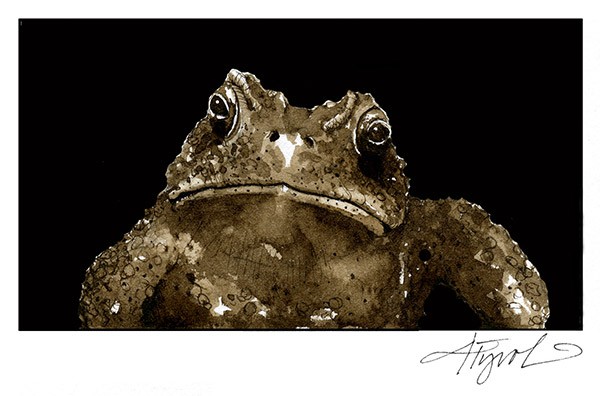
I manage a lodge in the Groton forest on behalf of Vermont State Parks. One warm fall day, while standing outside the lodge, I noticed movement inside one of the window wells around the basement. Realizing that something noteworthy was about to happen, I ran inside to alert our guests.
Together we all crouched to watch the methodical shaking of the earth below us. Slowly the ground moved a little to the left, then to the right, then there was a pause, then left again, right again. Eventually something reached the surface. I reached my hand out and gently touched the rough, bumpy, and very well camouflaged back of an American toad. It continued to emerge, fully exposing its body. The guests and I started pondering all sorts of questions about toads and their habits, but the biggest question of all was: where do toads go in the winter?
The American toad, Anaxyrus americanus (formerly Bufo americanus) typically hibernates underground, below the frost line. In the Northeast, toads are driven into their burrows sometime between September and October and re-emerge from April to May. Research suggests that toads may return to the same overwintering sites year after year. They may be loyal, but they don’t appear to be very picky: they live in gardens, forests, fields, and urban places. They also overwinter in a variety of sites.
What they need is loose soil to dig. Toads usually burrow one to two feet into the ground to get below the frost line, although younger toads have been observed burrowing less deeply. They will use existing mammal burrows if available. Ant mounds are also common overwintering sites. In urban areas, toads will often seek out foundations where cracks exist and burrow their way down into those crevices. Some toads overwinter in old tree stumps, and high concentrations of toads are often found under rocks and logs in wet areas around springs. Toads are thought to be solitary hibernators, however, when suitable habitat is scarce, communal overwintering has been documented. Over 600 Canadian toads were found burrowed together in a sandy hillside in Wood Buffalo National Park in Canada.
Toads enter their burrows at the same time they dig them. They back in snugly as their hind legs do the digging. As they recede into the burrow, the opening caves in over their heads. The toad draws its toes under itself, bends its head downwards, and enters into a torpid state. As long as the toad does not freeze, it will wake once the spring temperatures consistently start rising above 40 degrees.
I wondered how climate change might affect toads, so I contacted Jim Andrews, leader of the Vermont Reptile and Amphibian Atlas Project, and asked him if toads were resurfacing too early during unseasonably warm winter weather. He hadn’t noticed anything related to this, but he did wonder what a future with less snow cover might mean for toads. "If snow becomes less frequent, that could affect the depth of the soil freezing temperatures and result in greater mortality in toads and other amphibians,” Andrews said.
The toad mortality rate is impossible to predict in any given winter, but one study in Minnesota tracked 28 overwintering toads and found that 32 percent of them died. It stands to reason that a toad’s risk of becoming a meal decreases in the winter, as many of their predators, including snakes, skunks and raccoons, either hibernate or hole up for extended periods of time.
As I sit here with snowflakes falling about me, I think back to the warm, sunny days with the toads chomping away on insects in the lodge’s window wells. I hope they will survive these cold months undisturbed. But for now, sleep well little toads. We'll be waiting for you in the spring!


Discussion *